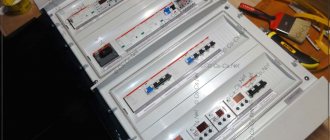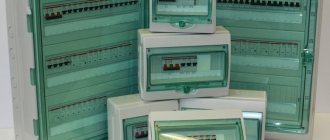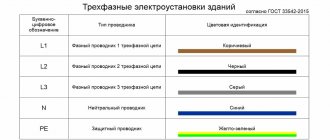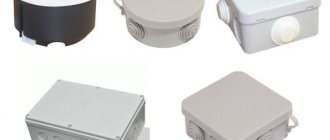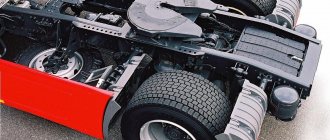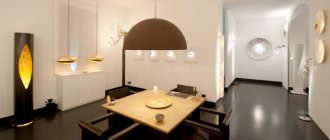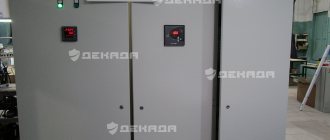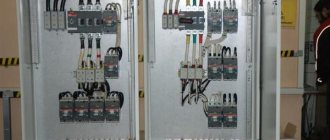The protective grounding conductor is connected to the PE bus, from which wiring is carried out throughout the premises. This is all the more important because when using fuses to save money and reduce the size of the ASU, switching devices are not installed in them, which is a serious drawback of such input-distribution devices.
On schematic electrical diagrams, all devices mounted in the switchboard are indicated by symbols and signed with certain letters.
As mentioned above, for large extended buildings the number of inputs can be increased. The rating of this differential circuit breaker should be 50 A, the leakage current rating should be 30 mA, its shutdown time in the event of a short circuit should be less than the shutdown time of the input circuit breakers. Automatic drawing of a single line diagram
The system is divided into nine consumer groups protected by automatic machines.
As calculations show, in most cases the voltage drop when turning on elevators exceeds the permissible value according to GOST. The last line, consisting of one RCD and two circuit breakers, is designed to protect the circuits of a separate room.
In Fig.
Diagram of an apartment switchboard equipped, along with other protective devices, with a voltage relay. This is a round flexible cable with double insulation and stranded conductors and is not recommended for hidden wiring. The cables shown in dashed lines are intended to power adjacent buildings in a main power supply circuit.
How to read electrical diagrams. Lesson #6
Input distribution device (IDU). Types and application
The name input-distribution device (IDU) indicates that it is mounted at the input of electrical networks of several consumers, distributes electricity across them, and allows automatic power outage in the event of malfunctions and short circuits.
With the help of an ASU, it is convenient to disconnect the electrical circuit in the house during repair work, or for a period of prolonged inactivity of the electrical circuit. In multi-storey residential buildings, such an input system is installed in vestibules or stairwells. In small two-story houses, such an electricity input device is placed on the outside of the house. In factories, such devices are mounted in the workshop or on the outer wall of the production building. Typically, the input distribution device is used for alternating current voltage of 220 or 380 V.
Types of ASU
Electricity distribution and input devices are classified according to various criteria: the number of protective and other devices, size, current strength. Some samples have a special place for energy meters, and there are also devices that control the operation of lighting. Electrical circuit breakers located in the ASU housing serve for automatic emergency de-energization of circuits.
According to the purpose and characteristics of the ASU device, they are divided into the following types:
- Input systems responsible for receiving electricity.
- Distribution type, designed for distribution and accounting of data.
- Input and distribution systems that simultaneously perform the functions of the two previous types.
By current load on:
- 250 amp.
- 400 amp.
- 630 amp.
Design features
These devices differ significantly in size, since much depends on the power of the connected consumers. In turn, this indicator is related to the number of consumers who need electricity.
The input distribution device belongs to the group of electrical devices, which include various devices. The ASU not only receives energy, but also distributes it among objects. Each large residential building must have a separate ASU installed.
If the main facility consists of additional individual consumers, then additional ASUs are installed at each facility.
ASU equipment and devices are placed in metal cabinets, which consist of the following parts:
- The wires are connected to the copper busbars using a bolted connection. To increase the reliability of contact of power circuits, spring washers are additionally used. The phase bus must have holes for connecting consumer phase conductors. Working neutral conductors going to the consumer are connected to the neutral bus, which has similar holes.
- The input machine is used to connect the power cable. The parameters of the machine are determined in accordance with the power supply project.
- Fuses can be installed instead of an input circuit breaker and are intended for the same purposes. Their rating is also selected in accordance with the load size.
- The input circuit breaker protects the electrical wiring of the household network from excessive loads, short circuits, and also for performing power outages for network maintenance.
- Voltage limiters or arresters. They are installed after the input machine. If pulse overvoltages occur, the arrester is triggered. In this case, phase voltage is supplied to the protective bus, as a result of which the protection of the switchgear is triggered.
- A group of machines for individual networks. The main task of these machines is to distribute electricity among separate groups. Each group serves a separate room in the apartment, lighting and other various consumers requiring separate protection. If necessary, install protective shutdown devices. The machines are connected taking into account a uniform load for all phases. The number of machines in each phase is determined by the highest load of the connected networks.
- Wires and terminal blocks for making various connections. The wires must have the insulation color according to their intended purpose: phase - red wire, neutral wire - blue, ground - yellow-green. The ends of the wires must be marked. The phase bars must be painted in different colors. Conductors must have insulation suitable for 660 volts. At the point where the wires are introduced into the input distribution device, they are enclosed in bushings to ensure reliable insulation.
- Electricity consumption metering devices. Metering devices installed in these devices make it possible to control electricity consumption and the optimal distribution of loads in different circuits.
Operating principle
- The main power cable is inserted directly into the ASU input machine. The rated current of this machine is determined in advance. Its value is fixed in the technical specifications. The input machine protects the electrical wiring in the event of an emergency.
- This machine can forcefully turn off the power supply for network maintenance. There are ASU designs in which the input machine is replaced by a special disconnector or switch.
- The next elements installed behind the input machine are arresters. They are used to connect the protective bus and phase conductors. When powerful pulses occur, the arresters are triggered, which activates the protection of the input distribution device.
- The distribution of power supply finally occurs across groups of conductors, and is carried out by circuit breakers of different ratings. An additional protective measure is a residual current device.
Areas of application of ASU
The use of ASUs has its own characteristics depending on the places of their application. Let's consider the main features of using ASU.
Electrical panel inspection
Once a year, specialists are required to conduct preventive inspections or audits of the electrical installation. But situations arise when it is necessary to look at the condition of the distribution system and the devices included in it. For example, having bought an apartment, it turns out that not everything is in order with the electrics:
- light flashes;
- There are problems with sockets.
The electrical panel needs to be inspected. We are talking about a switchboard located in an apartment, on the landing of an apartment building (see your section) or in a private house.
First of all, good lighting should be provided. Then you need to turn off all the machines, including the introductory one. During the inspection process, it is mandatory to follow safety precautions. If cracks and chips are found on the plastic shield, they need to be repaired. The shield cover must open and close freely.
Next you need to check all wire connections
You need to pay attention to the contact points; there should be no traces of rust or oxidation on them. If necessary, the connection must be disassembled and the ends of the wire stripped
On one of them, make a loop for the bolt and use a washer to connect the engraver again. To strengthen the nut connection, a lock nut is used.
In addition, it is necessary to prevent the grounding contact of the shield. This requires:
- remove the ground wire;
- clean it up;
- check the bolt;
- then make the connection and, if necessary, strengthen it with a second nut.
Purpose
ASU, UVR or input switchgear is a set of various electricity metering devices, circuit breakers, fuses, etc. Depending on the size, several dozen different switches, transformers, and meters can be placed in it. There is also an IVRU - such a passport for a standard IVR means that it is an inventory one.
Photo - ASU with meters
The main difference between the modernized IVRU and the standard one is its increased degree of anti-vandal protection, the ability to be used in field conditions and at facilities under construction.
Photo - IVRU
The main purpose of the input switchgear is to supply the building or individual parts of residential and industrial premises with electrical energy. It consists of panels that are of one-way service type, i.e. they open only on one side. Depending on the design, there are single, two and three panels. Accordingly, these are VRU-1, VRU-2 and VRU-3. In Russia, even four-panel versions are sold - ASU Main Switchboard GM MAGNET.
Photo - input device diagram
Professional companies (ABB - ABB, VRU IEK, Schneider and others) manufacture the input switchgear directly in the container. This shield is protected from environmental influences, moisture and dust on the moving mechanical parts of its parts, and from external physical influence. At the same time, the manufacturer can make an ASU to order, according to your requirements.
Why do you need an ASU:
- For the distribution of electric current throughout residential and non-residential buildings;
- To install all protection, control, metering and current measurement devices in one place;
- Many models are equipped with an additional switch that will help protect the electrical network of a cottage or apartment from short circuits and overloads;
- To quickly turn on and off power to individual devices or parts of buildings.
Note to management organizations
The changes made to SP-134 by order of the Ministry of Construction of the Russian Federation are relevant for organizations accepting new buildings for management. The innovations do not affect houses that are already in use until they undergo major repairs or reconstruction. In this case, the work project includes preparing the infrastructure for the placement of modern communication equipment.
At the same time, management organizations must remember that the general property of apartment buildings will include all elements of the engineering infrastructure created in accordance with SP-134: electrical panels, meters, cables, cabinets, etc. The management entity will be responsible for their maintenance and repair, which should be taken into account when determining tariff for services.
At the same time, Order No. 1718/pr does not in any way change the legal side of the issue: access to the common property of apartment buildings is still regulated by the Housing Code of the Russian Federation and is approved by the OSS in the house. The owners establish fees under agreements for the use of the common property of apartment buildings or decide on the issue of free installation of communication equipment.
The issue of admission of telecom operators to MKD is closely monitored by the Federal Antimonopoly Service. Preventing the provider from accessing the common property of the house is considered a violation of the requirements of Federal Law No. 135-FZ of July 26, 2006 “On the Protection of Competition.”
The department holds management organizations administratively liable for abuse of a dominant position under Part 1 of Art. 14.31 Code of Administrative Offenses of the Russian Federation. The article provides for punishment for organizations in the form of a fine from 300,000 to 1,000,000 rubles.
Hold a general meeting of owners of premises in an apartment building using the “OSS 100%” service and establish fees under agreements for the use of the common property of the apartment building or decide on the issue of free installation of communication equipment.
Subscribe to our newsletter
Receive weekly news from the housing and communal services sector, tips on managing apartment buildings and filling out the housing and communal services GIS. Select the email to which it is convenient for you to receive newsletters, join 36,825 subscribers
Specifications
Each input switchgear has its own characteristics (with automatic transfer switch, without it, with automatic switches, etc.). Before starting installation, you need to study all the data specified in the device passports. Let's look at the characteristics of the most popular models:
VP – model with switches. VP VRU-8500:
| Rated current, A | 630 |
| Voltage, V | 0,4 |
| Wear resistance | Unlimited |
| Stability, kA | 10 |
| Panel dimensions, mm | 1800 (2000)*800 |
Depending on needs, overall dimensions may vary. ASU of this type is recommended for installation in in-house switchboards. Not suitable for outdoor use.
| Current, A | 250 |
| Voltage, V | 380 |
| Embedded elements | Transformer, capacitor, automatic switches. The 400 A model comes with a meter |
| frequency Hz | 50 |
| Usage | In three, four and five wire networks |
A VROOM type device has similar characteristics.
| Network requirement, A/V | 220/380 |
| frequency Hz | 50 |
| Additional requirements | The network must have a solidly grounded neutral |
| Generally accepted standards of ASU (GOST, TU) | TU 3434-007-05774835-2002. |
The description of this switchgear is somewhat different from those discussed above. It is mainly used for private or industrial buildings and is suitable for outdoor installation. Marking:
- VRU (VU) – Input switchgear;
- 3 – panel third in development;
- C – certificate of the plant, in this case, the Starookolsky plant;
- M - a device of a modernized series (with a counter, automatic machines and lighting control).
Video: ASU of an apartment building
Lighting board (SHB)
Based on the name today, we can conclude that these devices are intended for control of lighting devices. Most often, such devices can be used in non-residential buildings that are large. Examples include shopping centers and food hypermarkets. The principle of operation of a lighting board is similar to that of a regular switch.
SCHO
As with any other type of equipment, you can install fuses here, as well as power meters. The most common model at the moment is considered to be a recessed lighting panel with a switch (UOSCHV). If necessary, its box can be easily mounted into a wall and disguised with finishing materials.
Requirements and installation of ASU
To assemble any input distribution board or connect a finished device, you will need special circuits. Depending on the type of installation, you will need to obtain permission from your electricity supplier.
Photo - example of an input circuit
The photo shows approximate input diagrams of this type:
- Switches and fuses for single input (a);
- Single input and circuit breaker (b);
- Switches and fuses (c);
- Double input, similar to scheme B (d);
- double with AVR (d).
The price of an input switchgear depends on its parameters and size. In addition to checking compliance with the quality certificate, it is also necessary to analyze the requirements that each ASU must meet:
- In order for the device to operate reliably and without failures, it is very important to check that circuit breakers and other protective devices can be installed on all input and output lines;
- When connecting an ASU, each node is connected according to the color coding of the wires and their purpose. It is also recommended to mark the cables if repairs to the input switchgear are required;
- Before purchasing, be sure to calculate the required current and network voltage.
You can buy ASU in any city in Russia and the CIS countries: Moscow, Minsk and others. You can also purchase an old shield on radio markets or Internet portals. The cost varies from several hundred to tens of thousands of rubles.
Login to the site
The metering of the switchboard is determined by installing an electric meter in it.
Types of devices installed in products of the VRU1 series
The input circuit depends on the circuit of external supply lines, the number of floors of the building and reliability requirements, the presence of elevators and other power electrical receivers, the presence of built-in enterprises and institutions, and the magnitude of electrical loads.
However, their installation is advisable, since the protective device at the input insures protection on the lines extending from the ASU, the failure of which leads to a shutdown at the substation and, consequently, to a call to the emergency service of the power system, and current-limiting fuses at the inputs make it possible to use lightweight equipment on the outgoing lines. Three circuit breakers are planned in the shield, in three groups. Measuring instruments: three ammeters with current transformers and one voltmeter with a switch must be installed at each input. There are more than a dozen schemes. For buildings above 16 floors, the diagram in Fig. Conventional graphic symbols in electrical diagrams are not defined by any single document. You may also be interested in the following repair articles:.
Read about demand factor in detail. Typical input diagrams. Measurements and accounting Accounting for active electricity consumed by common household consumers is carried out with three-phase direct-connection meters up to 50 A or through current transformers, which are installed on branches to the corresponding sections of the ASU buses. Wire from the voltage limiter arrester. Single-line diagram of house power supply.
Changes to SanPiN on the organization of places for communication equipment
Changes No. 1 to SanPiN 134.13330.2012, approved by order of the Ministry of Construction of the Russian Federation dated December 26, 2017 No. 1718/pr, take the first step towards simplified access for Internet providers to common property. They regulate the technical preparation of apartment buildings for the installation of equipment for the provision of communication services.
According to Order No. 1718/pr, SP-134 is supplemented with Section 8, which concerns the design of broadband, or high-speed, access networks (BBA) to communication services in apartment buildings under construction. The requirements of SP-134 also apply to work on major repairs of apartment buildings and renovation.
The standards prescribed in the new section are intended for builders and designers. Compliance with the new requirements will make it possible to install a modern communications infrastructure in an apartment building.
Engineering networks, according to paragraph. 8.1.4 SP-134, at least one subscriber point in each apartment must be ready to connect to communication services. The broadband access speed cannot be less than 100 Mbit/s (clause 8.1.5 SP-134). To provide residents of the house with access to the Internet, SP-134 allows the use of a telephone network (clause 8.1.1 SP-134).
According to clause 8.2.1 of SP-134, to make modern communication services available to residents of apartment buildings, when designing an apartment building, places for placing telecommunications equipment are provided. SanPiN offers floors, walls, ceilings, interfloor or wall niches, cabinets and boxes on the walls for these purposes.
Such places should be placed on each floor of an apartment building and even in the attic, if there is one. Places for equipment must have their own electrical cables, electrical panel and electricity meters (clause 8.2.8 SP-134).
If there are technical conditions and access to equipment for its maintenance and repair, the communication infrastructure can be placed on the upper floors, roofs and other structural elements of the apartment building. In this case, the requirements for noise levels, climatic conditions, and fire safety standards must be met (clause 8.2.2 SP-134).
This is interesting: Checking the extension cord for the possibility of hidden damage
Energy distribution in an apartment building with a TN-C system
TN-C is an outdated system, but it is actively used in old houses. This is a four-wire system consisting of three voltage phases and a combined neutral and working conductors (L1, L2, L3, PEN). In this PEN system, the conductor cannot be split and is delivered to the consumer in this form. It is also worth noting that quite often phase wires are given the names A, B, C.
As a result, with such a power supply system, with a single-phase connection, the consumer is connected with two wires (L, PEN), and with a three-phase connection with four (L1, L2, L3, PEN).
A power cable runs underground from the substation to the house. The cable enters the input box connected to the distribution board:
The risers laid vertically will extend from it. On each floor, floor panels will be connected to the risers, from which the apartments will be supplied with electricity.
Inputs can be made in various ways, this directly depends on the number of floors and size of the house, on the cable laying system (in the collector or in the ground). Why is that? Yes, because the load of a house with 100 apartments will be significantly lower than a house with 500 apartments. Moreover, the power supply requirements of, for example, a five-story building are relatively small - there are no elevators in the building and there is no need to install additional pumps to maintain water pressure, which cannot be said about a 30-story building where elevators and water supply pumps cannot be left without power.
It is for these reasons that not one, but two or more power supply cables with mutual redundancy can be installed in large houses. Distributing electrical energy between common building loads (elevators, entrance lighting, pumps) and apartments is a rather complex and time-consuming task. Distribution is carried out using complete electrical devices, the mounting methods, dimensions and installation locations of which are coordinated with the designs of the houses.
Let's look at options for connecting apartments to risers in apartment buildings with a TN-C system. The riser has four wires - three phases and one PEN conductor, designated in the diagram as A, B, C and PEN:
Between phases (A-B, C-B, C-A) the voltage will be 1.73 or more than between any of the phases and the neutral conductor (zero). From here we calculate the voltage between phase and neutral - 380/1.73 = 220 V. Two wires enter each of the apartments - phase and neutral. The current in both of these wires will be exactly the same.
They try to connect the load (in our case, apartments) evenly to different phases. In Figure a), out of six apartments, two are connected to each phase. Uniform connection makes it possible to reduce the neutral conductor current and avoid phase imbalance.
In old houses, combined electrical cabinets were sometimes used instead of floor panels. An example of such a cabinet is shown below:
This cabinet has compartments with separate doors. In one compartment there are signs with apartment numbers, switches and circuit breakers. In another there are meters, in the third there are low-current devices such as telephones, networks of television antennas, twisted pair cables for intercoms, the Internet and other devices.
In such a floor panel, each apartment has one switch and two automatic switches (the first for the general lighting line, and the second for plug sockets). Some versions of electrical cabinets may have a plug socket with a protective contact for connecting various machines (for example, cleaning machines).
Automation panel (ASB)
This device will be responsible for monitoring complex systems. All elements here will be managed automatically.
Automation mounting panel
The automation panel can be equipped with many sensors and controllers that will monitor various indicators. Based on these indicators, the device can independently turn off and turn on individual systems. The device can be used for a variety of tasks. In this case, in each individual case, various models of shields can be used. For example, if you use a boiler for a boiler, it can also be used for a ventilation system.
Tags: machine, ampere, sconce, input, view, choice, switch, house, , clamp, protective, sign, insulation, cable, like, design, , magnet, installation, load, voltage, neutral, nominal, lighting, skew, connection, potential, principle, check, wire, project, start, , work, size, relay, repair, socket, switch, row, light, network, system, connection, connection wire, resistance, circuit, ten, current, transformer, , installation, phase, panel, power supply, electrical panel
